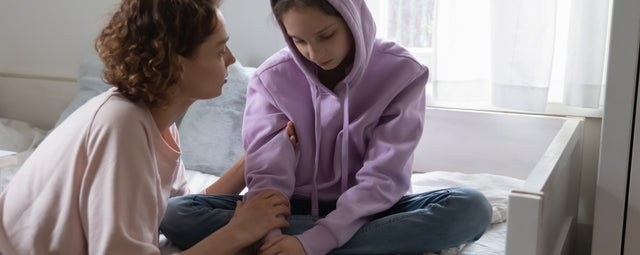Endometriosis and PCOS: how to tell the difference
Endometriosis and PCOS are very different health issues that are often swirled into one confusing conversation. While both impact millions of people who have vaginas and are of reproductive age, they are quite different in their nature, symptoms and treatments.So why the mix-up? Let’s look at the similarities, dissect the differences and clear up the confusion surrounding these 2 conditions.
What is endometriosis?
Endometriosis is a notoriously painful condition that affects 190 million people with a uterus globally. A 2018 study found it affects 10–15% of people with a uterus – that’s a lot of people fighting the endo battle.Endo is a chronic and progressive medical condition, which means it gets worse over time. It occurs when tissue similar to the lining inside the uterus – called the endometrium – goes for a bit of a wander. It sets up camp in the wrong places, growing outside the uterus in the ovaries, fallopian tubes and tissue lining the pelvis. It can even venture further afield, spreading beyond the pelvic region.
This act of bloody rebellion isn’t just an inconvenience – it can be extremely painful and life-altering. And it’s not just debilitating during menstruation, either. It can also cause pain during or after sex, and even give you grief when you go to the loo.
But wait, there’s more. Along with this pain comes a suite of unpleasantries: abdominal bloating that can make your jeans feel 2 sizes too small, nausea, fatigue, depression, anxiety, chronic pelvic pain, heavy bleeding during or between periods and difficulty getting pregnant.
So why would your uterus act out like this? Well, doctors don’t really know. What they do know is that certain factors may put you at greater risk of developing endo. These include:
- Period blood flowing backward, known as retrograde menstruation
- Cells outside the uterus acting weird and changing into endometrial-like cells
- The influence of estrogen – endometriosis is dependent on estrogen
- A rogue immune system not stopping the growth of the uterine lining-like cells outside your uterus
- Family history
- Long and heavy periods
- Getting your period before the age of 11
- Low body weight
- Drinking alcohol
- Having your first pregnancy at an older age
If you’ve been experiencing some yucky symptoms and are unsure about PCOS vs endometriosis and which one you might have, let’s investigate.
What is PCOS?
Unlike endo, polycystic ovarian syndrome (PCOS) is a hormonal condition. It affects up to 20% of people with ovaries during their reproductive years and is one of the leading causes of infertility. A 2017 study found that 80% of people with a uterus experiencing difficulty getting pregnant due to lack of ovulation have PCOS.But many people don’t even know they have it.
PCOS happens when the ovaries produce high levels of male hormones, which affects the menstrual cycle, among other effects. Like endometriosis, the cause is unknown, but it’s thought to be associated with increased insulin levels.
So is it genetics? Maybe. Lifestyle? Could be.
The symptoms range from irregular menstrual cycles, mood swings and sleep troubles to stubborn acne, obesity and excessive hair growth on the face and body. All in all, PCOS should seriously take a hike.
To add to the confusion, ‘polycystic ovary syndrome’ is a bit of a misnomer because the unwelcome intruders are not really cysts. They’re more like misunderstood eggs. Diagnosing PCOS involves chats with your doctor, blood tests and ultrasounds. It’s definitely not something you can self-diagnose.
An early diagnosis can help you better manage symptoms and avoid long-term repercussions. It’s worth the effort to get onto it quicksmart because PCOS can elevate your risk of:
- Type 2 or gestational diabetes
- Sexual health issues such as painful sex and low libido
- Sleep apnoea
- Heart disorders
Endometriosis vs PCOS: 2 ends of the spectrum
Endometriosis and PCOS are sometimes mentioned in the same breath, but they aren’t the same thing. We spoke with Dr Ashwini Gana Baskaran, principal GP at Sanctuary Wellness and Medical Centre, to clear up the confusion.Similarities
Both conditions occur in people of reproductive age who menstruate, and they can send your periods totally haywire. They are both associated with pelvic pain, fatigue, pain during or after sex and difficulties falling pregnant.
Apart from the fact that doctors don’t know what causes either endometriosis or PCOS, that’s where the similarities end.
Differences
Endometriosis is cells from the uterus going rogue, whereas PCOS is a hormonal disorder that’s characterised by hormonal imbalances and insulin resistance, and it can lead to acne, excess body hair and oily skin.
Why are endometriosis and PCOS often mixed up?
Endo and PCOS are clearly different, so why do they get mixed up?“They are 2 common conditions that happen in the reproductive age group,” says Dr Ashwini. “People tell me, ‘I’ve got painful periods and I’ve got endo’. I say, ‘Have you been diagnosed by a gynaecologist?’ They say, ‘No, I just thought painful periods was endo’. Maybe there’s a lot of Googling, and they haven’t necessarily been diagnosed.”
“The other reason it can be confusing is that for both conditions, we sometimes use hormones as treatments. So people may be on hormones but not actually understand what the pathology is.”
PCOS vs endometriosis: they’re both painful, but they’re not the same thing
While endo and PCOS are similar in that they are both a pain in the uterus (and other bits), they are fundamentally different and should be diagnosed by a medical professional. By getting up to speed on the facts, you can make informed decisions about your best care plan.Modibodi products can provide support for both disorders during times of heavy or irregular bleeding, thanks to their varying levels of absorbency. Our period undies are tested for maximum comfort and performance, making difficult periods easier to manage.
Keen for more info on all things menstruation and bodily fluids? There’s plenty more where this came from on our blog.






